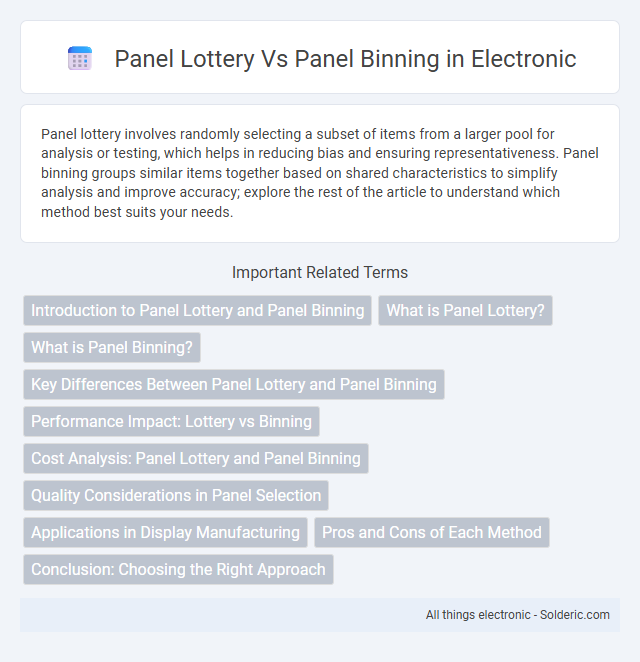Panel lottery involves randomly selecting a subset of items from a larger pool for analysis or testing, which helps in reducing bias and ensuring representativeness. Panel binning groups similar items together based on shared characteristics to simplify analysis and improve accuracy; explore the rest of the article to understand which method best suits your needs.
Comparison Table
| Feature | Panel Lottery | Panel Binning |
|---|---|---|
| Definition | Random selection of panels for surveys or studies. | Grouping panels into bins based on attributes or behaviors. |
| Purpose | Ensure unbiased, representative sample. | Segment panels for targeted analysis or advertising. |
| Methodology | Randomized, probabilistic selection process. | Deterministic clustering or classification techniques. |
| Use Cases | Sample surveys, market research studies. | Audience segmentation, personalized marketing. |
| Advantages | Reduces selection bias, simple implementation. | Improves targeting accuracy, enhances data insights. |
| Limitations | May lack granularity, less control over sample composition. | Requires detailed data, complex setup. |
| Data Dependency | Minimal data, focuses on randomness. | High data requirements for effective bin creation. |
Introduction to Panel Lottery and Panel Binning
Panel lottery is a method used in data sampling where participants are randomly selected from a larger population to ensure unbiased representation. Panel binning involves grouping panel members into homogeneous segments based on specific characteristics or behaviors, enhancing targeted analysis and insights. Both techniques optimize data accuracy and relevance in market research by balancing randomness and segmentation.
What is Panel Lottery?
Panel lottery is a method used to randomly select a subset of individuals or data points from a larger panel for analysis or survey participation, ensuring unbiased representation. Unlike panel binning, which groups participants based on shared characteristics or behaviors, panel lottery focuses on randomness to minimize selection bias. Your research or campaign outcomes depend on this approach to maintain statistical integrity and generalizability.
What is Panel Binning?
Panel binning is a quality control process used in the display manufacturing industry to categorize LCD or OLED panels based on specific optical and color performance criteria. It involves sorting panels into groups or "bins" according to brightness, color accuracy, and response time to ensure uniformity and meet product specifications. Panel binning helps manufacturers deliver consistent visual quality and optimize yield by matching panels with similar characteristics for various device models.
Key Differences Between Panel Lottery and Panel Binning
Panel lottery involves randomly selecting participants from a larger database to form a representative sample, emphasizing equal probability of selection for unbiased results. In contrast, panel binning categorizes participants into specific segments or bins based on attributes like demographics or behavior, optimizing targeted data analysis. The key difference lies in lottery's random selection versus binning's strategic grouping for customized insights.
Performance Impact: Lottery vs Binning
Panel lottery performance impacts rendering by dynamically selecting a subset of panels each frame, reducing GPU workload and improving frame rates with minimal memory overhead. Panel binning optimizes rendering by grouping panels into bins for batch processing, which lowers draw calls and enhances GPU efficiency but may increase memory use due to larger batch buffers. Your choice depends on whether you prioritize reduced runtime computation (lottery) or optimized batch throughput (binning) for better overall performance.
Cost Analysis: Panel Lottery and Panel Binning
Panel binning reduces costs by grouping participants into predefined segments, minimizing data overlap and streamlining data collection processes. Panel lottery incurs higher expenses due to random selection methods, requiring extensive recruitment and repeated surveys to maintain statistical significance. Cost efficiency in panel binning supports budget optimization, especially for large-scale market research projects.
Quality Considerations in Panel Selection
Quality considerations in panel selection emphasize accuracy, representativeness, and data integrity. Panel lottery methods can introduce sampling bias and variability, impacting data reliability, whereas panel binning groups participants based on predefined attributes, enhancing consistency and reducing noise. Choosing binning improves quality metrics by ensuring homogeneous segments and more precise targeting in analysis.
Applications in Display Manufacturing
Panel lottery and panel binning are critical quality control methods in display manufacturing used to categorize LCD and OLED panels based on their color uniformity, brightness, and defect levels. Panel lottery involves randomly selecting panels for inspection to assess overall production quality, while panel binning systematically sorts panels into graded categories to match specific device requirements and ensure color consistency across batches. These techniques optimize yield management, improve product reliability, and tailor panels for applications in smartphones, TVs, and monitors where precise display performance is essential.
Pros and Cons of Each Method
Panel lottery offers a randomized selection process that ensures unbiased representation but can result in uneven distribution and inefficiencies. Panel binning groups respondents based on similar characteristics, improving targeting accuracy and data reliability while risking potential bias and reduced sample diversity. Your choice between panel lottery and panel binning depends on balancing representativeness against precision in data analysis.
Conclusion: Choosing the Right Approach
Panel lottery offers a randomized, cost-effective method ideal for unbiased sampling in market research, while panel binning groups participants based on shared characteristics to enhance targeted analysis and improve data segmentation accuracy. Selecting the right approach depends on research objectives: use panel lottery for generalizable insights and panel binning for precise audience targeting and deeper behavioral understanding. Combining both techniques can optimize data quality and relevance in complex studies.
Panel lottery vs Panel binning Infographic

 solderic.com
solderic.com